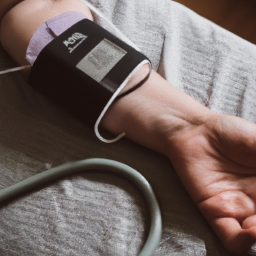The article discusses a recent study conducted by wearable technology expert WHOOP and West Virginia University, examining whether monitoring maternal heart rate variability (HRV) using the WHOOP strap could serve as a digital biomarker for preterm birth. Preterm birth, defined as delivery before the 37th week of pregnancy, can have serious health and developmental consequences for the baby. Current screening options for predicting preterm birth are limited, hence the need for alternative methods. The study involved 241 women who wore the WHOOP strap throughout their pregnancy, providing an average of 99.9 days of data from week 24 until delivery. The results showed that monitoring changes in nightly maternal HRV could potentially help identify an increased risk of preterm delivery, prompting further tests and medical interventions as necessary. However, the researchers emphasize the need for further research with a larger dataset to better understand this phenomenon on an individual level and accurately predict future preterm birth.
Read more about the latest articles
Background Information
Definition of preterm delivery
Preterm delivery refers to the birth of a baby before the completion of 37 weeks of pregnancy. It is a significant concern in healthcare due to the potential health and developmental challenges it can pose to the newborn. Predicting preterm delivery is a complex task, and it requires accurate screening methods to identify at-risk pregnancies.
Challenges in predicting preterm delivery
Predicting preterm delivery accurately is challenging for healthcare providers. The exact causes of preterm delivery are often unknown, and it can occur in both low-risk and high-risk pregnancies. Existing screening methods have limitations, and there is a need for more effective predictive tools to identify pregnancies at risk of preterm birth.
Current screening options for preterm delivery
Currently, healthcare providers use several screening options to assess the risk of preterm delivery. These include measuring cervical length, fetal fibronectin testing, fetal ultrasound, and assessing maternal risk factors such as previous preterm birth. While these methods have some predictive value, there is still a need for more accurate and reliable screening options.
Introduction of Wearable Device
Description of the WHOOP strap
The WHOOP strap is a wearable device developed by wearable technology expert WHOOP. It is designed to continuously monitor various physiological parameters, providing valuable insights into an individual’s health and well-being. The strap is worn on the wrist and uses advanced sensors to collect data.
Continuous monitoring of physiological parameters
One of the key features of the WHOOP strap is its ability to continuously monitor physiological parameters, including heart rate variability (HRV). HRV is a measure of the variation in time between consecutive heartbeats and is known to be influenced by various factors, including stress, exercise, and overall health. By recording HRV data over time, the strap provides a comprehensive view of the wearer’s physiological status.
HRV as a digital biomarker for preterm delivery
Researchers from WHOOP and West Virginia University have hypothesized that changes in maternal HRV could serve as a digital biomarker for preterm delivery. By analyzing HRV trends during pregnancy, it may be possible to identify patterns that are associated with an increased risk of preterm birth. This could potentially allow healthcare providers to intervene and provide appropriate care to prevent preterm delivery or manage it more effectively.
Previous Research Findings
Maternal HRV trends during pregnancy
Previous research has explored the relationship between maternal HRV and pregnancy. It has been observed that maternal HRV decreases during pregnancy until around 33 weeks of gestation, after which it increases again. This suggests that there may be significant changes in the autonomic nervous system activity during pregnancy, which can be reflected in HRV measurements.
Focus on pregnancies carried to term
Most previous research on HRV trends during pregnancy has focused on pregnancies carried to term. While these studies have provided valuable insights into the physiological changes that occur during pregnancy, there is a need to understand how HRV trends differ in preterm pregnancies. This knowledge can help in developing effective screening methods for preterm delivery.
Objective of the Study
Examining HRV trends in term and preterm pregnancies
The objective of the study conducted by WHOOP and West Virginia University was to examine HRV trends in both term and preterm pregnancies. By comparing HRV measurements in these two groups, the researchers aimed to identify any significant differences or patterns that may be indicative of preterm delivery.
Determining if changes in HRV indicate time to delivery or gestational age
Another objective of the study was to determine whether changes in HRV reflect the time to delivery or simply the gestational age of the pregnancy. This distinction is essential as it can help in accurately predicting preterm delivery and providing appropriate interventions when necessary.
Methodology
Participants and data collection
The study involved 241 women who gave birth between March 2021 and October 2022. All participants wore a WHOOP strap throughout their pregnancy, allowing for continuous monitoring of physiological parameters, including HRV. The strap recorded data at 30-second intervals during the night, providing a comprehensive dataset for analysis.
Analysis of HRV values
The researchers analyzed weekly averages of HRV values derived from the WHOOP strap measurements. This allowed them to track HRV trends over time and identify any patterns or changes that occurred during the course of the pregnancy. The analysis focused on the relationship between HRV and both gestational age and weeks until birth.
Mixed-effect spline models used
Two mixed-effect spline models were used to analyze the HRV data. One model related HRV to gestational age, while the other related HRV to weeks until birth. These models allowed for a comprehensive examination of the relationship between HRV and the progression of pregnancy, enabling the researchers to identify any significant correlations.
Results
Correlation between HRV trends and gestational age
The results of the study indicated a correlation between HRV trends and gestational age. As observed in previous research, maternal HRV decreased during pregnancy until around 33 weeks of gestation before increasing again. This consistent pattern suggests that there are significant physiological changes occurring during pregnancy that can be reflected in HRV measurements.
Correlation between HRV trends and weeks until birth
Interestingly, the study also found a stronger correlation between HRV trends and weeks until birth. Regardless of whether the pregnancy was carried to term or ended in preterm delivery, HRV trends were more closely related to the number of weeks until birth. This suggests that monitoring changes in maternal HRV could provide valuable insights into the timing of delivery.
Potential Application in Preterm Delivery
Identification of increased risk of preterm delivery
By monitoring changes in nightly maternal HRV, it may be possible to identify an increased risk of preterm delivery. The study’s findings suggest that certain HRV trends are indicative of the weeks until birth, providing an opportunity to intervene and provide appropriate care when necessary. This could help reduce the incidence of preterm delivery and improve outcomes for both mothers and babies.
Prompting further tests and medical interventions
The ability to predict preterm delivery using HRV trends could prompt healthcare providers to perform further tests and interventions. Early identification of an increased risk of preterm delivery can enable healthcare professionals to take proactive measures to manage the pregnancy effectively. This includes interventions such as progesterone supplementation, cervical cerclage, or close monitoring of the pregnancy to prevent complications.
Limitations and Future Research
Insufficient dataset for individual-level predictions
The current study was conducted using average values from groups of women. This means that the dataset is not sufficient for individual-level predictions of preterm delivery based on HRV measurements. Further research is needed to collect more extensive data and assess the usefulness of monitoring an inflection point in maternal vital signs on an individual basis.
Need for further research with a larger dataset
To validate the findings of the current study and develop an accurate predictive model, further research with a larger dataset is required. This will help determine the reliability and generalizability of the observed correlations between HRV trends and preterm delivery. Additionally, a larger dataset will enable more precise individual-level predictions.
Assessing the accuracy of inflection points in maternal vital signs
The study’s findings suggest that monitoring inflection points in maternal vital signs, specifically HRV, could be relevant in predicting preterm delivery. However, the accuracy and significance of these inflection points need to be further assessed. This includes determining the optimal timing of measurement and the specific HRV parameters that are most relevant for predicting preterm birth.
Read more about the latest articles
Current Investigation
Conducting more extensive research on HRV
Based on the promising results of the current study, further investigation into HRV trends and preterm delivery is warranted. This includes conducting more extensive research on a larger scale to validate the findings and confirm the predictive value of HRV monitoring.
Understanding the phenomenon at an individual level
Future research should aim to understand the relationship between HRV trends and preterm delivery at an individual level. This will help develop personalized predictive models that take into account the unique characteristics and circumstances of each pregnancy.
Determining the accuracy of predicting future preterm birth
Ultimately, the accuracy of predicting future preterm birth using HRV monitoring needs to be determined. Additional research should focus on assessing the effectiveness of HRV as a digital biomarker for preterm delivery and establishing the reliability of this predictive tool.
Conclusion
Potential of the wearable device in predicting preterm delivery
The study conducted by WHOOP and West Virginia University suggests that the WHOOP strap, with its continuous monitoring of HRV, holds potential for predicting preterm delivery. The observed correlations between HRV trends and gestational age, as well as weeks until birth, provide valuable insights into the physiological changes occurring during pregnancy.
Importance for pregnant women in areas with limited medical facilities
The wearable device’s potential for predicting preterm delivery is particularly crucial for pregnant women in areas with limited access to medical facilities. Preterm births often have worse outcomes in these regions, and early identification of an increased risk can lead to appropriate interventions and care that can help improve outcomes for both mother and baby.
Emphasis on the need for further research
Despite the promising findings, further research is needed to validate the observations and establish the accuracy of HRV as a digital biomarker for preterm delivery. Future studies should focus on larger datasets, individual-level predictions, and the assessment of inflection points in maternal vital signs. With continued research, wearable devices like the WHOOP strap could play a significant role in improving the prediction and management of preterm delivery.
















